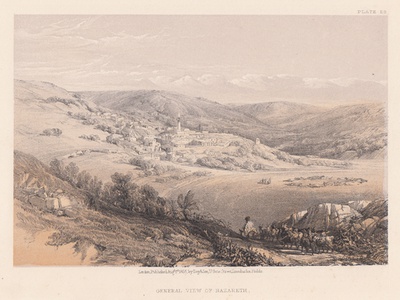| Method | Lithograph with tint stone |
| Artist | after David Roberts |
| Published | London, Published Augt. 1st. 1855, by Day & Son, 17, Gate Street, Lincoln's Inn Fields |
| Dimensions | Image 142 x 210 mm, Sheet 202 x 285 mm |
| Notes |
Plate 28 from Volume 1 of the small format reprint of Roberts' The Holy Land, Syria, Idumea, Arabia, Egypt & Nubia. A general view of the village of Nazareth, in Galilee, now the North District of Israel. Nazareth is important predominantly as the childhood home of Christ and the town of Mary, and has been a major site of pilgrimage for much of the Christian era. Settlement of the area dates to at least as early as the Middle Bronze Age, though it appears to have been abandoned in the eighth century BC due to Assyrian raids on the area. By the Roman period, it was little more than a small town of minimal importance. In the Islamic era, the town's Christian sites were destroyed, and at the time of Roberts' visit, only the Grotto of the Annunciation and the adjoining Franciscan structures were still extant. Since the mid-nineteenth century, the city has seen the construction of numerous Christian churches, as well as rapid expansion in population and it is now the largest city in North District Israel, often referred to as the 'Arab Capital' of Israel.' Roberts' view shows the town in its secluded position on the side of a valley. With the exception of the dome and minaret of a mosque, the town's skyline is mostly made up of residential buildings. On the plain at the foot of the hills is a circular encampment of tents, while in the foreground a herdsman leads a flock of horned goats down a steep path. David Roberts RA (24th October 1796 – 25th November 1864) was a Scottish painter. He is especially known for a prolific series of detailed prints of Egypt and the Near East produced during the 1840s from sketches made during long tours of the region (1838-1840). This work, and his large oil paintings of similar subjects, made him a prominent Orientalist painter. He was elected as a Royal Academician in 1841. The firm of Day & Haghe was one of the most prominent lithographic companies of the nineteenth-century. They were also amongst the foremost pioneers in the evolution of chromolithography. The firm was established in 1823 by William Day, but did not trade under the moniker of Day & Haghe until the arrival of Louis Haghe in 1831. In 1838, Day & Haghe were appointed as Lithographers to the Queen. However, and perhaps owing to the fact that there was never a formal partnership between the two, Haghe left the firm in the 1850's to devote himself to watercolour painting. The firm continued as Day & Son under the guidance of William Day the younger (1823 - 1906) but, as a result of a scandal involving Lajos Kossuth, was forced into liquidation in 1867. Vincent Brookes bought the company in the same year, and would produce the caricatures for Gibson Bowles' Vanity Fair magazine, as well as the illustrations for Cassells's Poultry Book, amongst other commissions. Condition: Light foxing to margins, not affecting image. |
| Framing | unmounted |
| Price | £30.00 |
| Stock ID | 39343 |

